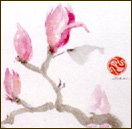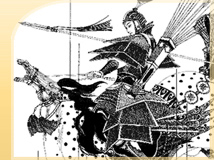
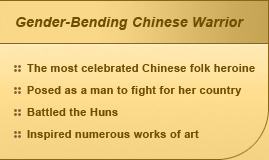
Hua Mulan, the well-known heroine of an ancient Chinese ballad, has inspired women for centuries. Determined to keep her brothers and father from fighting a war that would kill them, she disguised herself as a man and took their place on the battlefield. Refusing the gender-based limitations of her time, Mulan fought a deadly enemy for 12 years, and then returned home, resuming her former life. That a young girl in traditional China fought, undiscovered, as a man with great success—some accounts describe her as a general who earned the emperor’s favor with her military savvy—is amazing. The ease with which she performed her gender-bending, from female to male and back again, is even more fascinating—an ancient example of a woman sneaking into “a man’s world” and proving she belongs there.
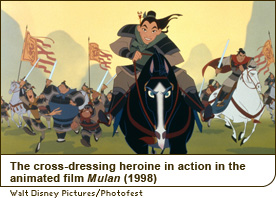
It’s no surprise that Mulan’s powerful tale of bravery and adventure has found mass appeal. In 1998, Disney brought the Chinese heroine to the world’s attention with its animated feature Mulan, which has grossed more than US$300 million worldwide. The tale was retold with a twist: Disney’s version is a coming-of-age story in which gender-crossing helps Mulan find enlightenment and “the real me inside.” And there are at least four Mulan-inspired feature films currently in development. One high-profile project will star Crouching Tiger, Hidden Dragon’s Michelle Yeoh as the daring, cross-dressing warrior.
But is Mulan simply a mythic figure, or are the legends based on a woman who actually lived? While scholars debate, Mulan remains a transnational icon whose adventures prove that a woman can excel in a man’s world—not only in combat but in anything she chooses to do.
A Legend Is Born
Mulan first appears in the Ballad of Mulan, written by an anonymous author sometime in the fifth or sixth century CE. Set around 300–400 CE, the poem tells the story of young Mulan, who is despondent because her father has been called to fight against invading Huns. Since her father, a former military officer, is too old to fight, and her brothers are too young, Mulan wants to go in their place.
She disguises herself as a man and buys equipment for a soldier’s life: a horse, a saddle, a harness and a whip. She then leaves her home to sleep by the Yellow River with the rest of the army. Traveling 10,000 miles to battle the enemy, Mulan bravely fights for 12 years without ever revealing her true sex. At the military campaign’s end, the emperor offers each soldier a cash prize. Mulan asks only for a camel on which she will return to her family.
Arriving home, Mulan retires her soldier’s uniform and once again dons traditional female attire. Her former military buddies are shocked to find out she is a woman. The ballad ends with a metaphor about two hares, male and female, running as fast as they can, suggesting that in the midst of war, soldiers do not distinguish between the sexes.
Multiple Mulans
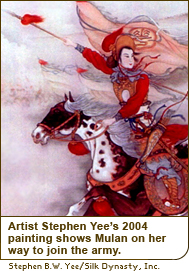
Disney was hardly the first entity to retell Mulan’s story—like all legends, her tale has evolved through the ages, and each adaptation recasts the heroine according to the cultural values of the time. In some accounts, Mulan is promoted to the rank of general for her military skill and command of strategy; in others, she settles into a more conventional woman’s role by marrying in the end. One version even ends with the emperor ordering Mulan back into service—as an imperial concubine. She refuses and commits suicide instead.
Later versions place more emphasis on the supposed disparity between Mulan’s warrior self and her womanly self. The most far-reaching embellishments were made during the Ming Dynasty (1368–1644) in a play titled Mulan, a Woman by Xu Wei (1521–1593). Xu Wei’s Mulan is excited about going to war, doing so less out of filial piety and more as a quest for adventure. In the play, the heroine, who wants to use the fighting skills her father has taught her, asks mockingly, “Should only men be heroes?”
A Real-Life Mulan?
So did Mulan really exist? Many of the details recounted in the Ballad of Mulan concur with imperial court anthologies (circa 1000 CE), which suggest that Mulan was indeed a historic figure. However, questions remain as to her exact origins, and several dynasties and provinces have claimed her as their own.
Some scholars believe that the Mulan legend is based on a real woman named Wei Hua Hu, who lived in the third century CE. Her story matches many of the events in the ballad: Hu was raised in a military family and taught by her father. When he was called to duty after retirement, she dressed as a man and went in his place. According to local annals from the time, she was stationed in Wan County and served in the imperial army for 12 years, receiving many promotions for her excellent service. No one realized she was a woman. When her duty ended, the emperor chose her to be a general. She refused his offer and, as in the fifth- or sixth-century poem, asked for a camel on which to return home.
While scholars debate the possible source for the Mulan legends, millions of Chinese consider her existence a historical fact. Regardless of her legitimacy, there’s no debate about the heroine’s popular significance: Mulan has symbolized norm-defying bravery in young women for millennia. The heroine is so celebrated in her homeland that she inspired a “Mulan complex” among young Chinese women in the early twentieth century. Many of them joined the mostly male professional workforce to emulate Mulan’s great crossing of the gender divide.
:: woa.tv staff
Hua Mulan Selected Sources





